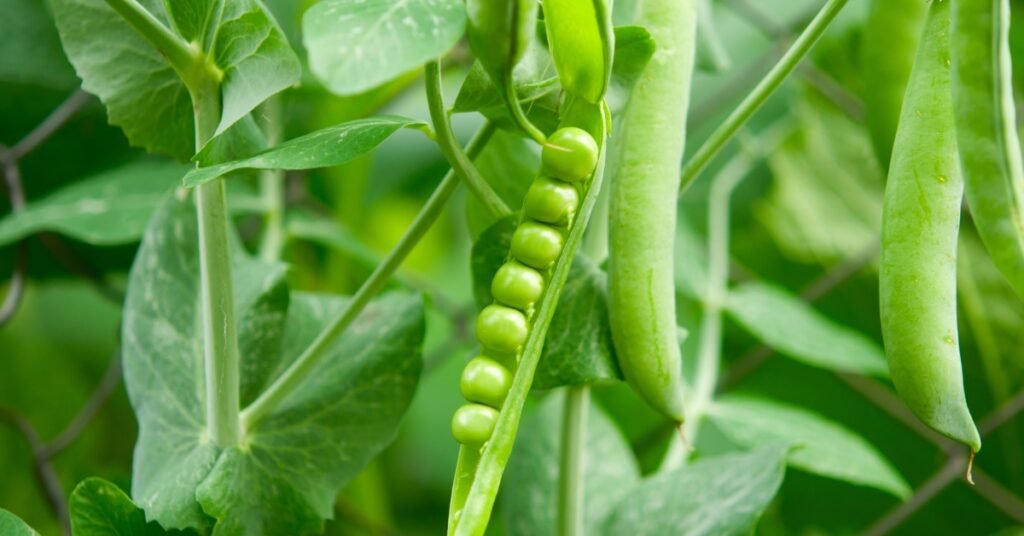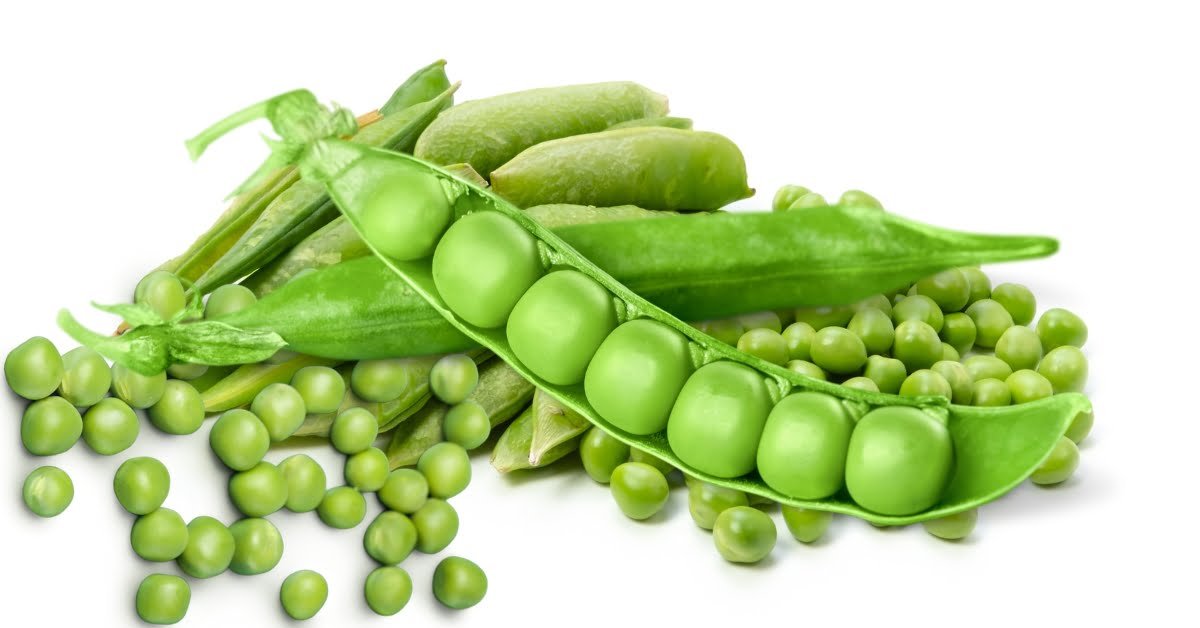Lillian‘s Caseload Pea is a superior variety of pea saved by Mennonite farmer Lillian after Johnny’s Seeds discontinued it. This heirloom variety has sweet, large peas and grows on vines 2–3 feet long with 5–7 peas per pod.
Lillian's Caseload Pea
| Common Names or AKA Names: |
|
| Botanical Name: | Pisum sativum |
| Family: | Fabaceae |
| Plant Type (Zone 8b): | Annual |
| Hardiness Zones: | Zones 2 through 11 |
| Mature Size: | 2′ – 3′ foot long vines. |
| Native Area: | Southern Europe |
| Bloom/Harvest Time: | Fall & Spring |
| Sun/Light Exposure: | 6 to 12 hours of Light. |
| Planting Depth: | 1″ inch deep. |
| Soil Preferences: | Well-Drained Loamy, Clay |
| Soil pH: | 6.0 – 7.5 pH |
| Aquaponically-Friendly: | YES | LEARN MORE |
| Hydroponically-Friendly: | YES | LEARN MORE |
DESCRIPTION:
Peas are a cool-season crop grown for their edible seed or seed pods. The pod and the seed within are a valuable food source around the world, and the flowers and young shoots can be eaten as well. In addition, peas also feed the soil by fixing nitrogen; certain varieties can be used as a cool-season cover crop for this reason. Peas are a cool-season crop and stop growing when temperatures reach 85F.
USE:
Peas are a versatile vegetable, with many different varieties to choose from. Sweet shelled peas, edible–podded peas, snap peas, Asian snow peas and the edible shoots of pea plants can all be used in unique and delicious ways. Snap and snow peas work well in Asian stir–frys while raw sweet shelled or edible podded peas make a great addition to salads with lemon juice drizzled over them for added zest. Wilting olive oil and garlic over your vegetables is also an excellent way to prepare them for dinner dishes such as Florentine seafood dishes where you could use pea shoots instead of spinach. Other tasty recipes include baking in white sauce au gratin or serving with cream cheese or mustard sauce – both options making sure that your family enjoys their meal!
Culture & Cultivation:
Pisum sativum, commonly known as the garden pea, is an ancient crop that has been grown since 7,000 B.C. in Eurasia and can be planted as a cool season crop between 55 to 65 degrees Fahrenheit. The best soil for growing peas should be fertile, moisture–retentive and neutral in pH level. Depending on the variety of pea being grown (either podded or peashoot), they may need to be staked or allowed to creep along the ground respectively. Common garden peas are harvested when almost mature with fibrous pods that cannot be eaten; however some varieties such as Pisum sativum var macrocarpon have edible pods and tender peas inside – these include sugar, snow and snap peas. Young tips from any variant of Pisum sativam are called pea shoots which can also make a delicious pot herb if cooked correctly! Smooth–seeded types are more cold-hardy than their wrinkled counterparts too. The genus name comes from Latin while ‘sativum‘ means cultivated – making it quite clear why this plant has been enjoyed by so many over thousands of years!
If you want to learn more about cultivating this specific plant, you might want to check out our online courses where we have plant specific mini courses in addition to our standard fully packed courses and master gardening courses.
Planting & Care:
Peas need full sun. They can be grown on a wide range of soil types. Sandy, quick-warming soils favor early planting and harvest, but moisture may be a problem in a dry season. Soils must have ample moisture in order for seeds to germinate. For late planting, a well drained clay loam is ideal because of its cooler temperatures. Well rotted manure, compost, green manure crops or similar organic materials will improve the water holding capacity of the soil and is best for crop production.
Peas should be planted as early as the soil can be properly prepared. They are usually one of the first crops planted in the spring. Peas can be planted either in single rows or wide rows.
Single rows: Tall varieties are best grown in two single rows spaced six inches apart with double rows spaced 20 to 30 inches apart. Plant seeds 1 ¼ inches deep with a one to three inch spacing between seeds. Soil temperature should be 40 F or above at planting time. The object of a double row is to provide space between the rows for a trellis to support tall varieties. It also
makes more efficient use of space.
Supports should be placed at planting time and may consist of brush four to five feet high after the stems have been pushed into the soil 12 to 18 inches. The brush should be well branched and close enough together to provide a ready hold for the pea vine tendrils. Chicken wire can be used. It should be four to five feet high, stretched as tight as possible between posts placed at
eight to ten foot intervals. Chicken wire can be rolled up and stored at the end of the season. Brush is not as easy to obtain or dispose of.
Wide rows: Dwarf varieties can be grown using the wide row method. Make a trench six inches to one foot wide and approximately two inches deep spacing the trenches two to three feet apart. Scatter seeds (spacing them one to two inches apart) in the trench. Cover lightly with soil.
Supports are not necessary although supports 15 to 18 inches high have proven successful.
Peas can be planted by the following three steps:
- Apply organic matter and recommended amounts of lime (if lime was not applied during
fall). - Rototill into soil.
- Broadcast recommended amounts of fertilizer prior to planting and work into soil.
- Plant.
At time of pod set it may be a good idea to apply a side-dressing of fertilizer. This is especially important on light sandy soils. For best results, work fertilizer into row with a light cultivation. Watering at this time would also be beneficial. To avoid burning roots, bands of fertilizer should be placed three to four inches away from the plant on each side.
Growing new plants can be difficult at times but not to worry Green Grass Grove Academy is here to help! We are excited to offer Online Courses on plant care and other Gardening and Homesteading Courses. Our goal is to provide you with the knowledge and skills necessary to become a successful gardener. Our Online Courses are designed to be self-paced and to be completed at your convenience. Courses contain invaluable information to help you become the ultimate Gardener! In addition, Our Courses have entertaining multimedia, quizzes, and a final exam to test your knowledge. Upon completion of each course, you are eligible to receive a certificate of completion. Some of our most popular courses include Aquaponics/Hydroponics, Plant Pathology, Seeds & Seedlings, Microgreens, Plant Mini-Courses, and Insect Pest & Nutrients Management.
So what are you waiting for? Come on over to Green Grass Grove Academy and let us help you become the ULTIMATE GROWER!
Watering:
Since peas are grown during cool weather irrigation is not usually necessary. However, if dry periods do occur, irrigate thoroughly early in the morning until the soil is moistened 8″ to 12″ inches deep.
Harvesting:
Pick when pods are filled with young tender peas. This means you may have to pick peas several different times during the harvest season, because they do not all mature at once. During maturity the sugar content of the pea seed decreases rapidly with an increase in starch.
Fully matured pods contain peas which are tough and flat in flavor. Handle peas quickly after harvest and keep them cool, preferable below 40F until eaten or marketed.
Edible podded peas are best when pods are two and half to three inches long. Peas should be picked before the pods become netted. Edible podded peas have strings that should be removed before eating. To remove the string, pinch the tip of the pea getting hold of the string.
Pull the string up the straightest side toward the stem; continue pulling string and pinch off the stem end.
Aphids | Cutworms | Seed Maggots | Pea Weevils | Slugs
Take Our Online Insect Pest Management Course to become an expert at dealing with these pests and others too!
Learn More About This Plant!
- Peas are an excellent choice for aquaponic gardens because they produce a lot of nitrogen–rich biomass that can be used as a food source for the fish. Additionally, peas do not need much space and have shallow root systems that make them suitable for growing in small tanks or other containers.
- Peas are a good choice for hydroponics because they require very little space and have shallow root systems that make them suitable for growing in small containers. Additionally, peas produce abundant amounts of nitrogen–rich biomass that can be used as a food source for the fish or other aquatic animals living in the system.
- Peas, like sweet corn, are highly perishable and in demand by local consumers. Peas are
difficult to grow when temperatures are high and the days are longer. Try later varieties for this
purpose. - Seeds are high in fiber, vitamins, and minerals including iron, magnesium, phosphorus, and zinc.
- Flowers taste like raw peas and along with young shoots, can be added to salads.
- Seeds can rot or seedlings damp off if planted too early in cold, wet soil
- Cutworms and aphids can be a problem, severing young shoots and spreading disease respectively, though the latter does not usually affect pods
- Powdery Mildew can occur in hot weather and affect both leaves and pods
- Root rot and fusarium wilt are common ailments that can cause roots and plants to wilt and die. Look for resistant varieties
The information in this post is NOT medical/nutrition advice, as we are not doctors or nutritionists. This information is for informational/entertainment purposes only and is not a substitute for professional medical advice, nutrition advice, diagnosis or treatment. If you have any concerns or questions about your health or nutrition intake, you should always consult with a doctor or other licensed and qualified healthcare professional.
Green Grass Grove Plant Profiles
No posts found!





